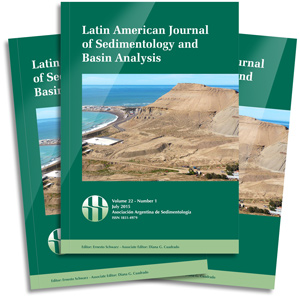Study of the variability in suspended sediment discharge at Manacapuru, Amazon River, Brazil
Keywords:
Suspended sediments; Acoustic Doppler Profiler; Amazon RiverAbstract
The Manacapuru hydrometric gauge station has been used for more than 30 years by the Brazilian National hydrometric network to provide data on the Solimões-Amazon River. At this place, the Solimões river average water discharge is about 103,000 m³ s-1, the mean width is 3,000 m and the mean depth is 20 m. The gauge station record represents the whole upstream contribution of the total suspended solids (TSS) from the Solimões basin, whose total area is approximately 2 x 106 km2, representing a runoff of 0.48 m³ s-1 km-2. TSS annual flow is approximately 400 x 106 t. The systematic TSS sampling procedures traditionally used at the Brazilian hydrometric network has limitations, some of them being related to local effects affecting the TSS flow. This article aims to study the local variability of TSS flow at Manacapuru station. The study was conducted in the scope of MESASOL and PIATAM IV projects, whose objectives are precisely to consider alternative methods for TSS flow assessment in the Amazon basin. It was identified that local geologic-geomorphologic features are related with the TSS flux spatial variability at the vicinity of the Manacapuru section. This results induce a new interpretation to the general sediment flux for the Solimões river basin, were local flux can’t be see as a total flux from the hole up-stream river basin.
References
Filizola N., 1999. O fluxo de sedimentos em suspensão nos rios da bacia Amazônica Brasileira. ANEEL, Brasilia. 63 pp.
Filizola, N., 2003. Transfert sédimentaire actuel par les fleuves amazoniens. Thése, UPS, Toulouse III, Toulouse, 273 pp.
Filizola, N. and J.L. Guyot, 2004. The use of Doppler technology for suspended sediment discharge determination in the River Amazon. Hydrological Sciences–Journal des Sciences Hydrologiques: 49(1)143-153.
Guy, H.P. and V.W. Norman, 1976. Field methods for measurements of fluvial sediment. In Techniques of Water-Resources Investigations of the U.S. Geological Survey, 3rd. ed., Chp.C2, Book 3, Denver. 59 pp.
Latrubesse, E. and E. Franzinelli, 2002. The Holocene alluvial plain of the middle Amazon River, Brazil. Geomorphology 44: 241-257.
Molinier, M., J.L. Guyot, E. De Oliveira, V. Guimarães and A. Chaves, 1995. Hydrologie du bassin de l’Amazone. In Proc. Grands Bassins Fluviaux Péri-atlantiques, vol. 1, 335-344. PEGI, Paris, France.
WMO, 1994. Guide to hydrological practices. WMO Geneve, Pun nº 168, 5th. ed., 735 pp.
Downloads
Published
How to Cite
Issue
Section
License

This work is licensed under a Creative Commons Attribution-NonCommercial 4.0 International License.




